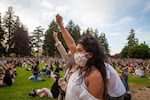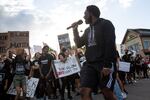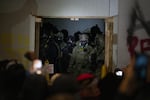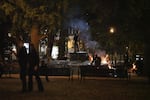Portland’s ongoing protests for racial justice have stretched for 65 days. The nightly demonstrations are unprecedented but also part of Oregon’s long history of prolonged uprisings for change.
For example, the 1934 Westcoast Waterfront Strike lasted 83 days and resulted in ports along the entire West Coast unionizing. In 1960, a worker strike against The Oregonian over a more automated printing process lasted for at least a year. The longest unrest in Oregon’s history likely dates back to the decades Indigenous communities actively resisted and fought against invading colonizers, who eventually founded the state of Oregon as a white utopia designed to oppress.
Consecutive days of people in the streets is easy to quantify. The birth and death of a movement, however, is more ephemeral. And like many protests before it, the latest demonstrations in Portland have some people asking at what point do they end — or whether they should.
With the federal law enforcement surge now poised to leave the city, the state enters a new phase. Elected leaders are finding they can no longer blame the White House for protests in Oregon. Rather, local leaders are being confronted with the same set of demands that have been at the forefront of this movement all along.

Attendees of the vigil for George Floyd raise their fists in Peninsula Park in Portland, Ore., Friday, May 29, 2020.
Claudia Meza / OPB
Furious over the killing of George Floyd by police in Minneapolis, protesters in Portland gathered May 29 in Peninsula Park, for a vigil. Speakers denounced racism. There were chants of “no justice, no peace,” and calls to resist a rising fascist tide. Then demonstrators marched downtown to the Multnomah County Justice Center. There, protesters broke windows. A group of about 30 people broke into the building and set a small fire. The night ignited a long overdue reckoning with racism and inequality in a state founded on both.
Local and state politicians responded with a series of initiatives, from trimming the police budget in Portland to a special legislative session that passed several proposals to revamp policing. While political leaders talked about acting at warp speed, many activists saw incremental reforms and platitudes.
“We need to witness a process of defunding and abolishing the police,” said Kinsey Smyth, an activist in Portland who started organizing during the protests. “This all began in response to police brutality and we are now being met with an escalation of police brutality … . This all began way before the feds were here.”
Thursday and Friday nights were the first in more than a month that protesters did not face repeated rounds of tear gas and crowd control munitions from local, state or federal law enforcement. Portland leaders hope the conflict-free demonstrations give them the chance to calm tensions and persuade a critical mass of city residents that they’re working on systemic changes.
“Protesting is as American as apple pie,” said Commissioner Jo Ann Hardesty, the sole Black member of the City Council and a longtime critic of police practices. She predicted protests will likely continue until the election and maybe after. But, she said, the tone and the tenor will no longer be focused on federal buildings. Instead, it will be focused on what the city, county and state need to do to ensure that Black lives really matter.

A demonstrator holds a police hat above Mayor Ted Wheeler's head at a protest against police brutality and systemic racism in Portland, Ore., July 22, 2020. Wheeler has faced criticism for the Portland Police Bureau's use of force against demonstrators long before federal officers' arrival.
Bradley W. Parks / OPB
With the federal surge ending, Portland Mayor Ted Wheeler said he sees a chance to clean up downtown and for the community to begin to heal. Wheeler has faced harsh criticism from demonstrators for allowing the Portland Police Bureau, an agency he oversees, to use tear gas during protests. More recently — after being tear gassed himself by federal officers — Wheeler has said he regrets allowing local police to use the chemical weapon so frequently. He also acknowledged the city has so far taken “baby steps” to address protester demands and has much more to do.
The protests will only end, Wheeler said, “when people see that those in positions of power and influence have heard and understood what’s being demanded and are taking concrete steps toward enacting those demands.”
‘How long will this go?’
“I have had enough,” said Smyth, 23, who has been a fixture at protests over the past two months. “That’s the only time I’ve used that word. But when I look at what our city officials have done specifically, I do not find it to be enough in any way.”
She said protesters want to see a transformation in policing.
“They ask us, ‘How long will this go?’” Jamal Williams said to a crowd of about 1,000 people Thursday — the first night of protests since federal law enforcement handed over responsibility for the courthouse exterior to Oregon State Police. “Well, how long does it take to get justice?”

Kinsey Smyth speaks to a crowd of demonstrators from the steps of the Multnomah County Justice Center in Portland, Ore., July 23, 2020.
Jonathan Levinson / OPB
Activists have laid out a set of policies they want implemented. Those include $50 million in cuts each to the Portland Police Bureau and Multnomah County Sheriff’s Office budgets. That money would then be reinvested into community health and public safety alternatives to police under the plan. It also includes a number of demands to address police violence, such as significant changes to departmental oversight and disciplinary actions.
“We need our elected leaders to use every tool at their disposal to end violence against our communities right now,” Portland State University professor of urban studies Lisa Bates told a crowd gathered in Pioneer Square on June 3, the sixth day of protests.
Police “attack us on film with no regard. They destroy people’s lives,” Bates said.
And some elected leaders are prepared to meet the call for change, like state Rep. Janelle Bynum, D-Happy Valley. Bynum chairs the House Judiciary Committee and is a member of the People of Color Caucus, which has initiated several new laws to reform policing.
“If people in leadership positions did not understand before the grievances of the Black community, they should understand now and they should not need any additional push to make the changes people are calling for,” Bynum said. “I don’t need another day of protests to know what my work is.”

Protesters march through the streets to protest police brutality Wednesday, June 3, 2020, in Happy Valley, Ore. Cities across the state including Happy Valley, Eugene, Hermiston, Pendleton, Burns, Grants Pass and others joined the nationwide cry for justice in the wake of George Floyd's death in Minnesota.
Bradley W. Parks / OPB
Elected leaders have felt pressure from the protests, but not necessarily because of some newly found commitment to racial justice.
“The economic impact of these protests has people at the table. And I can guarantee you if there were not economic impact in some way shape or form, they wouldn’t be so eager to change things,” Bynum said. “I’m not for graffiti, don’t get me wrong. But it is a manifestation of the pain and the infection that exists within our state with respect to how people of color are treated.”
Leaders take baby steps at warp speed
For a small window of time early in the protests, transformative change didn’t just seem possible, it felt inevitable.
“A revolution has started, do you hear me,” Hardesty, the Portland city commissioner, said June 6 to a crowd of thousands gathered at Waterfront Park, just blocks from the Justice Center. “You’ve got policy makers shaking in their boots.”
But policy makers, it turned out, weren’t shaking enough.
Early demands for deep, systemic change were instead met with what many activists viewed as incremental reform. Former police chief Jami Resch announced she was stepping down June 8 and was being replaced by Chuck Lovell, an 18-year veteran of the bureau and the city’s fourth Black police chief. His appointment was hailed as a tipping point by some community leaders, but derided as superficial by others.
After hundreds of community members testified and thousands wrote letters saying they wanted to see $50 million redirected from PPB’s budget back into the community, the Portland City Council — with the exception of Commissioner Chloe Eudaly, who demanded more — settled on a $15 million cut. There were additional budget cuts to PPB and all city bureaus in the wake of the global pandemic.
The reforms did little to placate protesters. Smyth called the reduction “absolutely insufficient.”

Federal officers confront people protesting racism and police violence in front of the Mark O. Hatfield federal courthouse on July 12, 2020.
Jonathan Levinson / OPB
It was into this environment that federal law enforcement officers arrived in the city in late June. President Trump’s show of force gave Wheeler and other leaders a common enemy against whom they and protesters could unite.
The day after it was revealed that federal law enforcement officers were using unmarked vehicles to grab protesters off the street with little explanation, Wheeler’s calendar began filling up with national media requests. And while organizers at the Multnomah County Justice Center and Mark O. Hatfield federal courthouse remained focused on racial justice, the magnetic pull of national politics and presidential Twitter spectacle slowly dominated the conversation.
Federal officers gassing blocks of downtown Portland as protesters fought back with shields and laser pointers became a regular scene on CNN and Fox News. President Trump called out for officers to “dominate” protesters, and Democrats lambasted the president as an authoritarian trying to distract from a sagging reelection campaign.
Some Black Portlanders wondered in editorial pages if the entire scene had become a distraction from racial justice. Even federal law enforcement officials agreed they can’t address protester demands.
“Ideally, it would come from the local elected representatives,” said one federal law enforcement official who was not authorized to speak on the record. “You’re not really seeing that.”
The official added that any solution to the demonstrations “has to come from the community.”
Katrina Holland, executive director of homeless services agency JOIN said she and her colleagues were concerned Oregon’s political leaders weren’t fully engaging with protester demands beyond the typical cycle of “acknowledgement and apology,” where leaders acknowledge Black people’s pain, apologize and promise to do better.
Holland said the tepid response didn’t rise to the occasion.
“I am not surprised that there are people in the streets every single night in the thousands,” Holland said. “Here we are talking about a giant systemic problem that is centuries old for which people are protesting in the streets, and sparse conversations didn’t really fit.”

A protester stands where an elk statue used to stand during protests against racism and police violence in Portland, Ore., on July 14, 2020.
Jonathan Levinson / OPB
So while fights with federal officers were still happening nightly on Portland streets, Holland gathered with Black-led organizations, individual Black activists and protest organizers to come up with a comprehensive proposal to address systemic racism in Oregon. The end result, called Reimagine Oregon, is an exhaustive set of policy solutions that go well beyond police brutality to address racism in areas like education, housing, health, transportation, economic development and community safety.
Each policy proposal has been assigned to a legislative lead, given a timeline and includes a likelihood for success. Reimagine Oregon’s backers see it as a roadmap to lasting change sought by people who, for generations, have been violently impacted by racism in the state.
Holland gives Wheeler some credit for showing up to their weekly meetings on a regular basis, and said the city made strong commitments on some of their proposals.
Efforts to dismantle systemic racism
The mayor and City Council have to stay focused on meaningful steps to dismantle Portland’s deep-seated racism, Holland said.
“That needs to be demonstrated in as many facets as possible, regardless of whatever’s happening,” she said. “I would like to see the city of Portland engage a little more.”
In Reimagine Oregon’s proposals, Wheeler is the legislative lead on a plan to ban the police use of chokeholds, even when an officer feels their life is in danger. The prognosis is “likely to happen” in the coming 30 to 90 days.
In other areas, the city has been less committal. Making it mandatory for Portland police officers to intervene when they witness excessive use of force, as an example, is marked as “in discussion.”
“They didn’t give a timeline. There were no legislative leads assigned to it,” Holland said. “There were some pretty big things that I know folks were disappointed about.”
Perhaps the biggest step the City Council has made so far is referring a measure to the November ballot that would create a new police oversight system. The sweeping proposal, crafted by Hardesty, gives a new community-dominated board the power to investigate complaints against police officers — and grants the power to discipline or terminate officers for wrongdoing. The board would receive at least 5% of the police budget. The entire measure has drawn intense opposition from the police union.
In the meantime, legislators are looking at a series of policing bills for an Aug. 10 special session that could go beyond actions they took in June. They include proposals to toughen police discipline and do more to curtail the use of chokeholds and tear gas.

Protesters gathered in front of the Multnomah County Justice Center and the federal courthouse in Portland, Ore., on day 63 of protests against systemic racism and police violence. It was the first night in more than three weeks that federal officers were not present.
Jonathan Levinson / Jonathan Levinson
Holland said the protests have value and she hopes they won’t go away. She pointed to white America’s favorite peaceful civil rights activist, Dr. Martin Luther King Jr., who said “riots are the language of the unheard.” But it’s not the protests, the federal police or Oregon State Police that she’ll be paying closest attention to in the coming days and weeks.
Clackamas and Washington counties as well as the Metro regional government have have promised to put time and money into creating a Black-led space that researches different public safety models and proposes changes to the criminal justice system. Reimagine Oregon is still waiting for commitments from the city of Portland and Multnomah County. Holland said if legislators are serious about their proposals, she expects to see movement on that in the next few weeks.
That sense of urgency for sweeping change extends beyond just policing.
“People are dying,” said University of Washington professor Megan Ming Francis, who specializes in the construction of rights and citizenship, Black political activism and the post-Civil War South. “Because people are going to be evicted from their homes. Because people can’t eat. Because there’s billionaires who are continuing to make money and people are just fighting to survive. And that only lasts so long before the masses are like, ‘You know what? Nah.’”
Francis said the coronavirus pandemic primed broad swaths of society to understand structural inequality and realize just how far it reaches into American institutions. She said an increasing number of people have lost health care, are being evicted or don’t have a job, and they are realizing the state doesn’t protect them.
To end these protests means transformative change, she said. It means people in power actually give up some of that power.
“And that is something that people in power do not want to do,” Francis said. “It’s clear that protesters can see through the BS.”
For Portland demonstrators, the protests have proven a useful tool to shift conversations around inequality and to make powerful people listen.
“I hope protesting never ends,” Smyth said. “I hope that there is the constant questioning and checking in with the most vulnerable and seeing how, and in which ways, they have fallen through the gaps.”